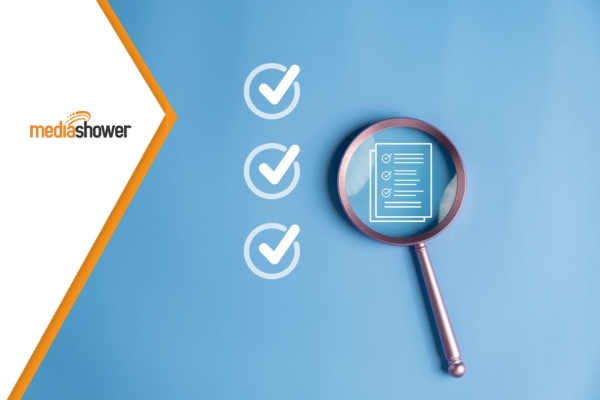Create a Style Guide with AI (+ Prompts and Best Practices)

If you’re looking for a style guide to help showcase your company brand, this is the guide for you. We’ve included our best AI prompts to help you generate them quickly, along with style guide FAQs and best practices.
Stand out with a tailor-made style guide, curated by Media Shower’s experts. Click for a demo.
First, Generate Your Marketing Overview
Paste the following prompt into ChatGPT or a similar AI tool:
Hello! I’m a busy marketing manager who wants to create a concise marketing overview for my business. I need your assistance in this process. Please ask the following 10 questions, one at a time.– What is the name of your business?
– Please provide a link to your website.
– What industry does your business operate in?
– What products or services does your business offer?
– Who is your target audience or customer base?
– What is their pain point?
– What is the unique value proposition or key differentiator of your business?
– How long has your business been operating?
– What are the main goals and objectives of your business?
– Are there any specific marketing channels or strategies that you have used in the past?
Based on my answers, please generate a marketing overview that can serve as a primer for future AI prompts. Leverage the 24 VIA character strengths where appropriate. Then let’s check the marketing overview for accuracy, asking any clarifying follow-up questions if needed.
Then, Generate Your Style Guide
In the same chat session, paste the following prompt:
Based on this marketing overview, I would like to create a style guide for my business. Please ask the following questions, one at a time, allowing me to skip questions I don’t know.
- What’s the current brand voice: formal, casual, playful, authoritative, or something else?
- Are there any specific colors or design elements associated with your brand?
- What are the main values or principles your business wants to convey through content?
- Are there existing content guidelines or style preferences you want to maintain or evolve?
- Do you have a preference for certain typography or font styles?
- Which competitors’ styles do you admire or want to differentiate from?
- Are there specific cultural or regional nuances to consider in the style guide?
- How frequently does your business update marketing content?
- Do you have different content types (e.g., blogs, whitepapers, social media) that need unique style considerations?
- How do you prefer to receive feedback or revisions on the style guide once it’s created?
Based on my answers, please generate a draft style guide. Leverage the 24 VIA character strengths where appropriate. Then let’s check the generated guide for accuracy, asking any clarifying follow-up questions if needed.
More Prompts for Creating Style Guides with AI
Once you’ve drafted your style guide above, use these prompts to polish and perfect it.
- Refine Voice & Tone:
“Alter this section to sound more [authoritative/casual/approachable].” - Clarify Brand Identity:
“Provide a version that resonates with a [younger / older / tech-savvy audience].” - Enhance Visual Consistency:
“Suggest imagery styles that align with a [luxury/minimalist/vintage] brand.” - Perfect Color Palettes:
“Recommend color schemes for a [calming/energetic/luxurious] feel.” - Determine Typography:
“Show examples of fonts suitable for a [professional/artistic/fun] brand.” - Optimize Layout:
“Describe ideal layout designs for [mobile / print/web] readability.” - Structure Content:
“Outline a format for short / long-form content that suits an [educational/entertainment/news] brand.” - Highlight Key Elements:
“Identify must-have elements for an [e-commerce/B2B/travel brand’s] style guide.” - Capture Brand Essence:
“Draft a mission statement encapsulating a [community-driven / innovative/eco-friendly] brand.” - Feedback on Current Guide:
“Review and suggest improvements for the current style guide based on [modern/classic/niche] branding principles.”
Style Guide Examples
Style Guide Example: NexaPoint Tech
The rationale for the NexaPoint Tech style guide is rooted in aligning the company’s marketing and communication efforts with its brand identity, values, and goals. Here’s a breakdown of the key elements:
Brand Voice (Formal and Authoritative):
NexaPoint Tech operates in a specialized and critical industry—network security. A formal and authoritative voice reinforces the company’s expertise and reliability, essential traits for building trust with a sophisticated audience like IT and business decision-makers.
Brand Colors (Red and Black):
Red is often associated with energy, strength, and action, which aligns with NexaPoint Tech’s dynamic and proactive approach to network security. Black denotes sophistication and formality, reinforcing the company’s professional image.
Content Values and Principles:
Emphasizing NexaPoint Tech as an authoritative leader and trusted partner in network security directly addresses the customer’s pain point of finding a reliable security solution. This messaging strategy leverages the VIA character strengths of Wisdom (expertise) and Justice (fairness and inclusivity).
Typography (Sans Serif for Web, Serif for Print):
This choice balances readability with a professional appearance. Sans-serif fonts are typically more legible on digital screens, while serif fonts lend a traditional and formal feel to printed materials.
Competitor Differentiation:
By avoiding overly casual styles, NexaPoint Tech distinguishes itself from competitors who might opt for a less formal approach, thereby reinforcing its position as a serious and reliable player in the industry.
Cultural and Regional Considerations:
Inclusivity, especially towards the LGBTQ+ community, reflects modern, progressive business values. Focusing on the US and EU markets ensures that content is culturally relevant and resonant with the primary audience.
Content Update Frequency (Annually):
Regular updates keep the marketing content fresh and relevant, adapting to any industry changes or new trends, which is crucial in the fast-evolving tech sector.
Content Types and Style Considerations:
Tailoring the style for different content types (blogs, whitepapers, social media, etc.) ensures that each piece is effective in its format while maintaining a cohesive brand voice and identity.
Feedback and Revisions (Internal Review):
Involving the marketing and sales teams in the feedback process promotes a collaborative approach, ensuring that the content aligns with both sales strategies and marketing goals.
This style guide ensures consistency across all marketing communications, establishes a strong brand identity, and effectively engages and converts the target audience. It leverages VIA character strengths to infuse ethical and value-driven principles into the brand’s voice and messaging.
Brand Voice
Tone: Formal and authoritative.
Character Strengths: Wisdom (expertise in network security), Courage (leadership), Justice (fairness and openness).
Brand Colors and Design Elements
Primary Colors: Red and Black.
Visual Style: Professional, sleek, and modern.
Content Values and Principles
Message: NexaPoint Tech is a leader and reliable partner in network security.
Character Strengths: Authority (being a leader in the field), Humanity (inclusive and fair).
Typography:
Web Content: Sans-serif fonts.
Print Content: Serif fonts.
Guideline: Easy to read, professional, not too casual.
Competitor Differentiation
Style: Avoid overly casual styles.
Focus: Maintain a professional, expert-driven approach
Cultural and Regional Considerations
Inclusivity: Embrace LGBTQ+ inclusivity.
Regional Focus: Tailored to US and EU markets.
Content Update Frequency
Schedule: Annually revising marketing content.
Content Types and Style Considerations
Blogs, Whitepapers, Ebooks: Informative, detailed, and expert-driven.
Social Media Posts: Engaging, concise, authoritative.
Website Landing Pages: Clear, persuasive, and easy to navigate.
Print Ads (One-Pagers): Visually striking, succinct, and informative.
Feedback and Revisions
Process: Internal review by marketing and sales teams.
Character Strengths: Prudence (careful consideration), Teamwork (collaborative feedback).
Note: This style guide draft leverages VIA character strengths to align NexaPoint Tech’s marketing communications with its core values and brand identity. It’s structured to provide clarity and direction across various content types, ensuring a consistent and effective brand voice.
Style Guide Best Practices
- Consistent Brand Voice: Ensure a unified voice that matches your brand’s personality, be it formal, playful, authoritative, etc.
- Visual Elements: Define color palettes, logo usage, and typography rules clearly.
- Content Structure: Standardize formats for different content types, from blog posts to whitepapers.
- Cultural Sensitivity: Address any cultural or regional nuances that impact your content.
- Regular Updates: Review and refresh the style guide annually or after major brand shifts.
- Feedback Loop: Allow content creators to provide input and feedback on the guide’s effectiveness.
- Accessibility: Ensure content guidelines support accessibility for all users, considering visual or hearing impairments.
Unlock the future of style guides, powered by Media Shower’s AI platform. Click to try us out.

Frequently Asked Questions About Style Guides
Why is a style guide necessary for my brand?
A style guide ensures brand consistency across all content and marketing materials. It fosters recognition and trust among your target audience.
How often should I update my style guide?
It's advisable to review your style guide annually, or after significant brand or market changes. Regular updates keep it relevant and aligned with evolving brand goals.
What should be included in a digital versus print style guide?
Digital guides should focus on website design, social media graphics, and accessibility. Print guides emphasize physical dimensions, paper types, and print-specific color codes.
How do I enforce the style guide across my team?
Introduce the guide during team training sessions and integrate it into content creation workflows. Regular audits and feedback sessions can ensure adherence.
Can style guides evolve with brand shifts?
Absolutely, style guides are dynamic documents that should evolve as your brand grows and shifts. They reflect the brand's current identity and values.
Is a style guide only about visuals?
No. While visuals are crucial, style guides also address tone, voice, language usage, and content structure. They offer a comprehensive approach to brand presentation.
Protips for Creating Style Guides
- Brand Consistency: Highlight core values. Maintain a fixed set of brand colors, fonts, and voice to reinforce brand identity across platforms.
- User Accessibility: Prioritize inclusivity. Ensure your style guide promotes content that’s accessible to all, including those with disabilities.
- Digital Adaptability: Design for screens. Optimize graphic elements and typography for various digital devices and screen sizes.
- Content Structure: Organize for clarity. Standardize the format for different content types, enhancing readability and cohesion.
- Cultural Nuances: Address global audiences. Ensure your style guide respects and addresses various cultural, regional, and linguistic nuances.
- Feedback Integration: Evolve with insights. Regularly collect feedback on the style guide from content creators and adjust as needed.
- Training Importance: Educate the team. Host regular training sessions to ensure your team is updated on the latest style guide rules and best practices.
At Media Shower, we’ve developed over 100,000 marketing materials for 500 clients. Click here to learn more about our AI-powered platform, and get a free trial.


